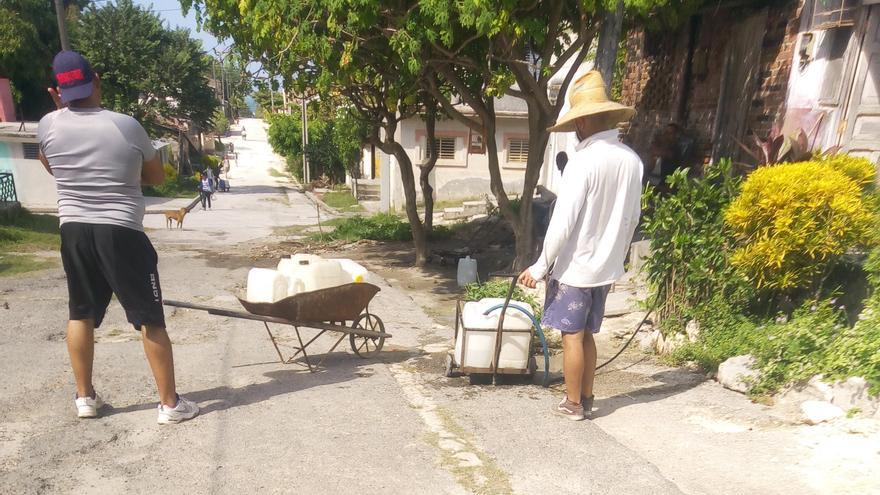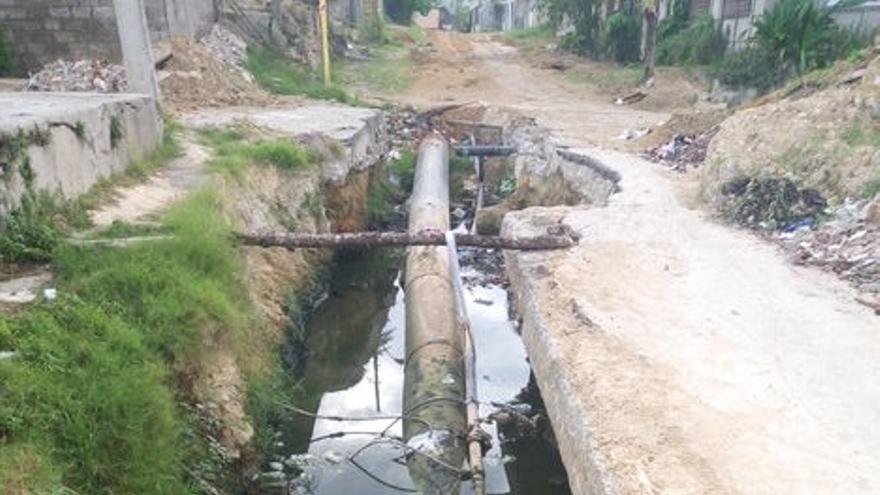
![]() 14ymedio, Juan Matos, Manzanillo (Granma province) | December 27, 2023 — When the families of Manzanillo, in the province of Granma, see a water truck parked on the corner of any neighborhood, the line takes only a few minutes to form. With a sudden drought, which compromises all the lines of production and daily life, arriving first – gallon container or bucket in hand – is not a matter of well-being or comfort, but of survival.
14ymedio, Juan Matos, Manzanillo (Granma province) | December 27, 2023 — When the families of Manzanillo, in the province of Granma, see a water truck parked on the corner of any neighborhood, the line takes only a few minutes to form. With a sudden drought, which compromises all the lines of production and daily life, arriving first – gallon container or bucket in hand – is not a matter of well-being or comfort, but of survival.
Even the streets of Manzanillo are eloquent about the water shortage. Dusty and yellow, when a pipa [water truck] spills a little water on the pavement, the dogs rush to lap up the liquid. If the water truck is not sent by Communal Services but must be paid by the families themselves, it is not uncommon for a single 55-gallon tank to cost 400 pesos*. At the end of the day, the business owner makes a good profit, and demand is increasing.
The lack of supply is inversely proportional to the price of products in the municipality, especially when it comes to fruits and vegetables. In a province with many farmers, the scarcity of resources has skyrocketed the price of a pound of beans to 500 pesos, a pound of rice to 150 pesos and that of pork – for whose rearing and hygiene water is indispensable – to 450. The work that is done so that an arid and battered land bears fruit, say the farmers, is titanic, although it cannot be expressed in numbers.
Nature has also begun to take its toll on the people of Manzanillo, whose authorities have been neglecting the province’s hydraulic infrastructure for decades. Last April, as a desperate measure to achieve the “sanitation” of dry areas such as Manzanillo, Deputy Prime Minister Inés María Chapman accepted from the hands of the Chinese ambassador to Havana, Ma Hui, a donation of 449 pieces of aqueduct and sewer system equipment.
Although the equipment – whose cost was 27.8 million dollars – was destined for the entire Island, the municipality of Granma topped the list of potential beneficiaries of the project, which included 93 water trucks, 60 unclogging trucks with high-pressure hoses and tools to repair leaks.

Of the formidable investment, as announced by the official media at the time, little actually reached Manzanillo, through whose avenues a single water truck was circulating this week. With hats and shirts – the sun of eastern Cuba does not give respite even in December – the neighbors get in line with wheelbarrows, jars and cans. Although there are young people in line, those who have the time and patience to wait their turn for several hours, often having traveled great distances, are the elderly, housewives and even children.
A few steps away, a collapsed stretch of sidewalk gives the measure of the unhealthiness in the municipality and the state of its hydraulic network. From a stagnant puddle full of garbage emerges, patched, one of the pipes that transport the town’s water, when there is some. The earth-colored liquid arrives in homes, and any precautions, such as boiling or chlorinating, are few.
Fainting or fatigue of the elderly who, poorly fed, carry a bucket to their homes is not uncommon. But there is no remedy: no one knows when the water truck will pass again, and they need to carry as much as possible. The free distribution points, opened by the Government in the vulnerable communities of Manzanillo, are not always supplied.
Although the entire Island faces the same problem of deterioration of its aqueducts and sewers, the east of the country has been especially affected by the drought. The province that has generated the most headlines has been Las Tunas, whose governor had to be held accountable last Friday to Parliament for the water crisis in municipalities that no longer know how to ask the Government for help.
The situation, according to the official press, has reached a “critical point,” in particular due to the extreme deterioration of pumping equipment. The local authorities, who depend on the “directions” from Havana, said that they could only make “patches” to the devices, which “can break at any time.”
Despair due to the lack of water reaches all parts of the eastern provinces, from the most populated cities such as Santiago de Cuba and Holguín, to the most humble hamlets of Guantánamo and Granma. Unable to solve the problem, the authorities call, of course, for “solidarity among neighbors”: “The situation is difficult, and no one can be certain. If you have a well, provide water to your neighbor, and if you have a cistern, save,” was the empty advice, of a manager of Aqueducts and Sewerage in Las Tunas.
*Translator’s note: Figures for December 2023: The minimum pension in Cuba stands at 1,528 pesos per month; that is, less than 60 euros, and the minimum wage at 2,100 (80 euros).
Translated by Regina Anavy
____________
COLLABORATE WITH OUR WORK: The 14ymedio team is committed to practicing serious journalism that reflects Cuba’s reality in all its depth. Thank you for joining us on this long journey. We invite you to continue supporting us by becoming a member of 14ymedio now. Together we can continue transforming journalism in Cuba.
